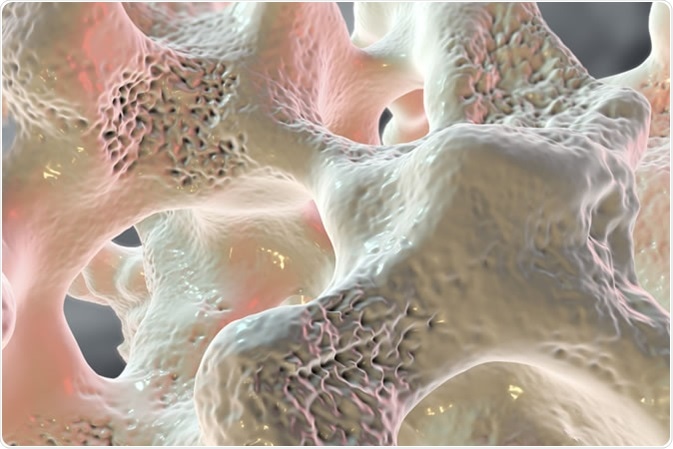Skip to:
Osteoporosis is a disease characterized by low bone mass and the weakening of bone tissue that is typically seen in elderly women. This is dangerous as it leads to an increased risk of bone fractures. Adequate calcium and vitamin D intake are safe ways to reduce the risk of osteoporosis-related fractures.

Spongy bone tissue affected by osteoporosis, 3D illustration - Image Credit: Kateryna Kon / Shutterstock
Calcium and Vitamin D
Calcium is an essential mineral that is necessary for life. It is the most abundant mineral in the body, and for humans, its main responsibility is to help maintain and build healthy bones. Calcium is also involved in the blood clotting process of wound healing, skeletal muscle contraction, and cardiac muscle contraction.
The daily recommended intake of calcium is as follows: women age 50 and below, and men age 70 and below need 1,000 mg of calcium. Women age 51 and over, and men age 71 and over need 1,200 mg of calcium. Calcium can be gained from calcium-rich food sources such as dairy products (including milk and cheese), green vegetables, some cereals, and some bread. Calcium can also be gained from calcium supplements for individuals that struggle to gain enough from their diets.
Vitamin D is a fat-soluble vitamin that is involved in the protection of bones. This is achieved by aiding in the absorption of calcium and supporting muscles to avoid falls. The daily recommended intake for vitamin D is between 400-800 international units (IU) for individuals age 50 years and below, and between 800-1,000 IU for individuals age 51 and over. It is also advised by the institute of medicine that the daily upper limit of vitamin D is 4,000 IU. The sources of vitamin D include sunlight, food, and supplements.
Vitamin D is made by the skin when exposed to sunlight, this is stored in fat cells for later use. Factors such as aging, reduced time outdoors, and using sunscreen can reduce the ability to make vitamin from sunlight. Therefore, vitamin D deficiencies may be treated by aquiring it from food or supplements. Foods that contain vitamin D include fatty fish, certain dairy products, and certain fruit juices. There are two types of Vitamin D supplements: vitamin D2 and vitamin D3.
What is osteoporosis?
Osteoporosis is a systemic progressive skeletal disease that is characterized by a lower bone mass (also known as bone mineral density [BMD]) and deterioration of bone tissue. This makes the bone more fragile making an individual more susceptible to bone fractures. Unfortunately, osteoporosis is a silent disease that has no symptoms and usually goes unnoticed until fractures occur.
A BMD value that is 2 standard deviations or below the mean BMD value is classified as osteoporosis. The assessment of an individual’s BMD also allows for predictions to be made regarding their likelihood of future fractures.
Common fracture sites associated with osteoporosis include vertebral bodies, distal radius, proximal humerus, pelvis, and proximal femur. . In the U.S. each year approximately 300,000 people are hospitalized for hip fractures and they account for approximately half of the total annual fractures within the UK, which results in an approximate 29% mortality rate within 12 months.
There are several types of osteoporosis which fall under two main groups: Primary (or idiopathic) osteoporosis and secondary osteoporosis. Primary osteoporosis includes juvenile osteoporosis seen in children and adolescents, postmenopausal osteoporosis seen in elderly women, and senile osteoporosis seen in elderly individuals (this type mainly affects elderly men).
Secondary osteoporosis encompasses all conditions that have osteoporosis-related symptoms as a secondary effect arising from the primary effects/symptoms of the disease. Causes of secondary osteoporosis include malignancy, systemic inflammatory diseases, and the use of certain mediations (e.g. glucocorticoids, aromatase inhibitors).
Other risk factors that can contribute to osteoporosis-related fractures include low body mass index (BMI), history of prior fractures at sites common for osteoporosis, parental history of hip fractures, being prone to falls, smoking, taking glucocorticoids, alcohol consumption, and rheumatoid arthritis.
Diagnosis of osteoporosis involves applying dual-energy X-ray absorptiometry (DXA) to the femoral neck of the hip. This is due to the femoral neck being the site of higher fracture risk.
Other non-invasive diagnostic methods include quantitative ultrasound and computed axial tomography. These techniques may also be used together at different points of a patient’s skeletal assessment (diagnosis, prognosis, monitoring treatment).
How calcium and vitamin D can help osteoporosis
The guide for the prevention and treatment of osteoporosis was first developed by the National Osteoporosis Foundation (NOF) and other medical experts in the field of bone health. This guidelines includes recommendations to reduce the risk of developing osteoporosis in postmenopausal women and men age 50 and over.
These recommendations include consuming adequate amounts of calcium and vitamin D, regular muscle-strengthening exercise, assessing personal risk factors for falls, reducing tobacco smoking and alcohol intake.

Natural sources of vitamin D. - Image Credit: Ekaterina Markelova / Shutterstock
Treatment options include pharmacological treatments (includes bisphosphonates, estrogen agonist/antagonist, parathyroid hormones, etc.), and physical therapy (following a fracture).
Lifelong adequate calcium and vitamin D intake are necessary for an individual to reach peak bone mass, as skeletal bones contain approximately 99% of the calcium within the body and vitamin D aids in the absorption of calcium.
Sources
- National Osteoporosis Foundation. (2019). Calcium/Vitamin D Requirements, Recommended Foods & Supplements. https://www.nof.org/patients/treatment/calciumvitamin-d/
- Ods.od.nih.gov. (2019). Office of Dietary Supplements - Vitamin D. https://ods.od.nih.gov/factsheets/VitaminD-HealthProfessional/
- Ods.od.nih.gov. (2019). Office of Dietary Supplements - Calcium. https://ods.od.nih.gov/factsheets/Calcium-HealthProfessional/
- Compston, J., Cooper, A., Cooper, C., Gittoes, N., Gregson, C., Harvey, N., Hope, S., Kanis, J., McCloskey, E., Poole, K., Reid, D., Selby, P., Thompson, F., Thurston, A. and Vine, N. (2017). UK clinical guideline for the prevention and treatment of osteoporosis. Archives of Osteoporosis. https://dx.doi.org/10.1007%2Fs11657-017-0324-5
- Cosman, F., de Beur, S., LeBoff, M., Lewiecki, E., Tanner, B., Randall, S. and Lindsay, R. (2015). Erratum to: Clinician’s guide to prevention and treatment of osteoporosis. Osteoporosis International. https://dx.doi.org/10.1007%2Fs00198-014-2794-2
- Tarantino, U., et al. (2017). Clinical guidelines for the prevention and treatment of osteoporosis: summary statements and recommendations from the Italian Society for Orthopaedics and Traumatology. Journal of Orthopaedics and Traumatology. https://dx.doi.org/10.1007%2Fs10195-017-0474-7
Further Reading
Last Updated: Sep 22, 2019